
MFH Home
Family Trees
Records
Wills
MIs
Studies
Memories
People
Places
Related Families
Odds & Ends
Mail David
Family Status
of a Yeoman Family: A Social Study
A family with a coat of arms which has been used through the ages with pride (1), might be expected to be of a relatively high status. Throughout the period of study, nearly all the male MAYs for whom an occupation is known were farmers, millers, mealman or brewers (i.e. maltsters). Of the farmers, only one has been discovered as recorded beneath the status of yeoman: Christopher MAY (1601-1644) of Worting was a husbandman in 1636, though he did later become a yeoman. The description of yeoman implies a man of some social standing, though not quite a gentleman. Yeoman would have owned and cultivated a small estate, most probably on a freehold basis. The millers in the family appear to have been of similar status to yeoman: most cases having indications that the MAYs owned the mills, at least on a leasehold basis, as well as running them. The mealmen were similar. The maltsters could be roughly equal to yeomen but, as shall be shown, several of them became gentlemen through the manipulation of ready cash.
The status of MAY family members is known mostly from the time of their deaths, as it is recorded in their wills (see fig.3). This was, of course, their own assessment of status though, on the whole, it was probably accepted by those around them, as shown in other documents of the time. It would be ill advised to infer that status at death implies the same social standing throughout life. However, most documents recording a man’s status, date to the period of his middle age or after, usually when his father is already dead. Thus, he has usually already risen through any social scale. Furthermore, descriptions are very dependant on the describer. There is a fine line between being a husbandman or yeoman, a yeoman or gentleman, and not all writers will use the same criteria. Still, status at death can give a relative idea of whether different branches of the MAY family rose up the social ladder over the generations.
Name |
Lifespan |
Occupation
or Status with Date
of Record |
|
John |
1600-1676 |
Unknown |
|
Christopher |
1601-1644 |
Husbandman
(1636), Yeoman (1639) |
|
John |
1630-1680 |
Yeoman
(1679) |
|
Christopher |
c.1633-1697 |
Maltster
(1684), Yeoman (1693) |
|
Thomas |
c.1654-1718 |
Yeoman
(1715) |
|
John |
1652-1722 |
Yeoman
(1682/86), Gentleman (1718) |
|
Christopher |
c.1656-1694 |
Tanner
(1682) |
|
John |
1668-1716 |
Mr.
(1700), Yeoman (1716) |
|
Charles |
1670-1714 |
Mr.
(1714), Gentleman (1714), Maltster (1714) |
|
Daniel |
c.1676-1740 |
Maltster
(1714), Mealman (1740) |
|
John |
1684-1752 |
Mr.
(1752), Gentleman (1737/39/44/46/51) |
|
James |
1700-1774 |
Yeoman
(1727), Gentleman (1773) |
|
William |
1709-1777 |
Yeoman
(1175), Mr. (1777) |
|
Daniel |
1711-1753 |
Gentleman
(1753) |
|
Thomas |
1712-1769 |
Mr.
(1737), Gentleman (1760) |
|
Charles |
1715-1745 |
Miller
(1745) |
|
James |
1728-1772 |
Mealman
(1771) |
|
William |
1729-1797 |
Brewer
(1778/79/81), Gentleman (1785/97) |
|
Daniel |
1734-1773 |
Miller
(1773) |
|
Thomas |
1737-1800 |
Miller
(1775), Brewer (1778/79/81), Gentleman (1785/1800), Mr. (1800) |
|
John |
1741-1802 |
Yeoman
(1801) |
|
William |
1745-1828 |
Yeoman
(1826) |
|
Charles |
1752-1807 |
Yeoman
(1807) |
|
James |
1760-1805 |
Gentleman
(1805) |
|
John |
1764-1809 |
Mr.
(1809), Mealman (1809) |
|
Thomas |
1764-1843 |
Brewer,
Maltster & Farmer (1784-1843), Esq. (1843) |
|
William |
1766-1833 |
Yeoman
(1795) |
|
William |
1767-1842 |
Gentleman
(1842) |
|
Charles |
1767-1843 |
Brewer,
Maltster & Farmer (1784-1844), Esq. (1844) |
|
Daniel |
1771-1851 |
Mealman
(1841), Miller (1845), Gentleman (1845/47/51) |
|
John |
1775-1866 |
Farmer
(1841/51/61), Gentleman (1859) |
|
John |
1776-c.1857 |
Miller
(1847/54), Gentleman (1847/54) |
|
William |
1780-1862 |
Miller
(1847/54), Gentleman (1854) |
|
Daniel |
1789-1845 |
Yeoman
(1845) |
|
James |
1790-1840 |
Farmer
(1819) |
|
Charles |
1796-1881 |
Druggist
& Chemist (1847-57), Gentleman (1847/54) |
|
George |
1799-1884 |
Surgeon
(1847/54/57/62/84), Gentleman (1854) |
|
William |
1793-1873 |
Miller
(1825) |
|
Charles |
1800-1841 |
Brewer,
Maltster & Farmer (1841) |
|
John |
1802-1837 |
Miller
(1837) |
|
Henry |
1804-1835 |
Gentleman
(1835) |
|
Edward |
1805-1869 |
Surgeon
(1847/62) |
In the early seventeenth century there is only documentation surviving for the status of Christopher MAY (1601-1644) of Worting, as mentioned in a deposition of 1636, where he is described as a husbandman. Three years later, he was a yeoman in a land obligation. This may indeed show a rise in standing, for Christopher was still a young man. It is doubtful, however, whether any conclusions about the status of early MAYs can be drawn from this seventeenth century reference to a husbandman, since Christopher was a second son and may not have started his adult life with the same status as his father. Christopher’s nephews, John MAY (1630-1680) of Worting and Christopher MAY (d.1697) of Basing, were both yeoman at their deaths. Some idea of the lifestyle of John can be gained from the inventory of his farmhouse which accompanied his will. His possessions were valued at £658, 5s 8d, compared with his father’s £410, 15s 6d. He grew barley, oats, peas, vetches and wheat; and kept cows, pigs and sheep, some three hundred and fifty of the latter. His house had eleven rooms, plus a cellar and wool loft, and contained many luxurious items (see fig.4).
John’s brother, Christopher (d.1697) was also a yeoman at death, though he was recorded as a maltster in 1684, despite being a yeoman three years previously. John’s eldest son, and namesake, was, like his father, a yeoman, being described so in 1682 and 1686 when he was called as a witness at the local quarter session court. By the time of his death, in 1722, he had risen to be a gentleman. this was the standing of the primary branch of the family when they died out.
Christopher MAY (d.1697) of Basing had five sons whose status is known. The eldest, Thomas (d.1718) of Nately Scures, unlike his cousin, failed to rise above the status achieved by his father, but was still a wealthy yeoman at his death and was eligible to vote for the local Knight of the Shire (the equivalent of an M.P. today). Christopher (d.1694) of Basing, the presumed second son, was a tanner, in 1682, when he witnessed an assault on one Eleanor BOX of Worting. It is unknown if his trade prospered to the level of his brother’s farm, but, perhaps, the fact that his grandfather picked him out for a special legacy might indicate not. John (1668-1716) of Basing, the third son, was known as Mr. MAY at his marriage and a yeoman, like his eldest brother, at his death. He was also eligible to vote for the local Knight of the Shire. Charles MAY (1670-1714) of Basingstoke, the next son, though recorded as merely a maltster in his will, was much more than this. In 1704, he had become a Burgess of Basingstoke and, in 1710, an Alderman. The following year, he was elected to the office of Mayor of the town, which office he held at the time of his death (Baigent & Millard 1889). In 1711, he also purchased the Manor of Sulhamstead Abbots (Berkshire) from his Lordship the second Earl of Abingdon (V.C.H. Berks 1906). Hence his description on his, now lost, memorial as a gentleman (May 1916), socially above his brothers. Charles MAY’s will makes it clear that he was also a miller, for he leaves his mills to his brother, Daniel (d.1740), in trust for his son of the same name. These would appear to have been the mills of Burghfield (Berkshire) and Sherfield-on-Loddon (Hampshire), whose inventory of 1717, Emma THOYTS records, was once in the THOYTS family papers (Thoyts c.1890). It was probably such diversity of business which enabled Charles to climb the social ladder. Daniel (d.1740), the penultimate son of Christopher MAY (d.1697) of Basing, was a salter of Quenhithe (London) according to an obligation dated 1714 (H.R.O. 44M66/E/T28) but, by 1715, he was back in North-east Hampshire, being a Burgess of Basingstoke (Baigent & Millard 1889). This was, obviously, an office deserved of some respect, but his status is otherwise difficult to gauge. His will records him as a mealman of Burghfield, and it is probable that he bought the mill there, along with that at Sherfield, from his nephew, for they were later in the hands of his heirs (2). He was probably the milling equivalent of a yeoman, though he may have been higher.
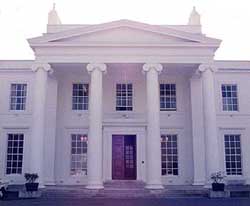 The family of
Thomas MAY (d.1718) of Nately Scures can be considered as the secondary
branch of the MAY family after the MAYs of Worting, and the family of his
brother, Charles MAY (1670-1714) of Basingstoke, as the tertiary branch.
The tertiary branch was evidently elevated above their cousins on the
social plain. Charles MAY (1670-1714) had only one son who survived him,
Daniel (1711-1753) of Sulhamstead, who seems to have concentrated his
money in land and farming, though, essentially, he was a country
gentleman, the Lord of the Manor of Sulhamstead Abbots. He built the
present Sulhamstead House between 1744 and 1748 (E....
1978, Thames Valley Police 1984, Thoyts 1887-93) and was obviously
recorded as a gentleman at his
death. He was buried in a private vault beneath Sulhamstead Abbots Church,
but no memorial survives (Thoyts
1887-93). He had no children and it was left to his sister’s family,
the THOYTS’, to move in such lofty social circles (3).
The family of
Thomas MAY (d.1718) of Nately Scures can be considered as the secondary
branch of the MAY family after the MAYs of Worting, and the family of his
brother, Charles MAY (1670-1714) of Basingstoke, as the tertiary branch.
The tertiary branch was evidently elevated above their cousins on the
social plain. Charles MAY (1670-1714) had only one son who survived him,
Daniel (1711-1753) of Sulhamstead, who seems to have concentrated his
money in land and farming, though, essentially, he was a country
gentleman, the Lord of the Manor of Sulhamstead Abbots. He built the
present Sulhamstead House between 1744 and 1748 (E....
1978, Thames Valley Police 1984, Thoyts 1887-93) and was obviously
recorded as a gentleman at his
death. He was buried in a private vault beneath Sulhamstead Abbots Church,
but no memorial survives (Thoyts
1887-93). He had no children and it was left to his sister’s family,
the THOYTS’, to move in such lofty social circles (3).
Thomas MAY
(d.1718) of Nately Scures had seven sons but, unfortunately, nothing is
known of five of these. The eldest son (of Thomas’ second marriage),
John MAY (1684-1752) of Sherfield, is one of the most documented
characters on the family tree and, throughout, is described as a gentleman.
He, again, was eligible to vote for the Knight of the Shire. Between 1711
and 1740, he lived in Sherfield-on-Loddon, being recorded at his son’s
baptism as of Sherfield Court.
Mary Anne MAY (1848-1932) wrote that there was a stone with his name
inscribed upon it, dated 1706 (4),
within the house (May 1916).
Sherfield Court was the old manor house of Sherfield-on-Loddon and John,
no doubt, led the life of a country gentleman there, though he did not own
the manor. By the end of his life, he was living at Huish Farm in Nately
Scures, but his will reveals something of this lifestyle. Amongst numerous
items are such luxuries as the
looking glass in the back chamber; six chairs purchased
of Spencer and the six black
chairs in the parlour - obviously sets; the clock case and its
belongings on the staircase showing that Huish had a turning stair with a
platform; a plum-tree table;
five dozen pewter plates and eight pewter dishes; all his chinaware; six
silver teaspoons, two large silver spoons and his largest
silver tankard; four barrels of liquor with M stamped upon them; and among his wife’s possessions, the
little sorrel gelding on which she rides, with both side saddles and
bridles. James MAY (1700-1774) of Theale, the youngest surviving son
of Thomas (d.1718), was known as a yeoman
at his marriage, in 1727, but, by his death, he had 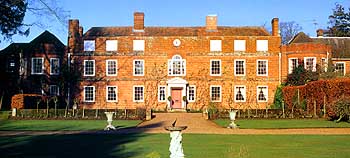 risen to become his
brother’s equal as a gentleman. Unfortunately, little is known of this important
character. He lived at Long Sutton (Hampshire) and, later, Theale
(Berkshire) and was one of the earliest subscribers, in this part of the
country, to the Society for the Propagation of the Gospel (May
1916). His luxurious possessions included a set of four 1746 silver
salt cellars marked with the MAY family crest which was sold by the family
to pay death duties in 1917 (May
1917).
risen to become his
brother’s equal as a gentleman. Unfortunately, little is known of this important
character. He lived at Long Sutton (Hampshire) and, later, Theale
(Berkshire) and was one of the earliest subscribers, in this part of the
country, to the Society for the Propagation of the Gospel (May
1916). His luxurious possessions included a set of four 1746 silver
salt cellars marked with the MAY family crest which was sold by the family
to pay death duties in 1917 (May
1917).
Here, again, the family splits into two distinct groups: the family of John MAY (1684-1752) of Sherfield stayed in Hampshire as the elder branch. The younger branch, descendants of James MAY (1700-1774) of Theale, moved into Berkshire. To take the eldest branch first, John’s eldest surviving son, William (1709-1777) of Bramley, did not maintain the status of a gentleman held by his father, but was described as a yeoman in his will and Mr. at his burial. Yet, his brother, Thomas (1712-1769) of Worting, a Mr. at his marriage, in 1737, rose to be a gentleman in 1760. The youngest brother, Charles (1715-1745) of Burghfield, was a miller, but died young, hence his standing is difficult to assess. a comparison of the wills of William and Thomas (and the latter’s widow) seem to suggest that William was by far the better off of the two. Though social standing and wealth do not necessarily coincide, it seems likely that both were, in fact, of the same status. All three of William (1709-1777) of Bramley’s sons remained as yeomen. The eldest, John (1741-1802) of Nately Scures, owned land in Basing and Mapledurwell, as well as the farms of Huish and Water End (which included the alehouse) in his home parish. He helped pay for the rebuilding of the Nately Scures Church belfry and had his own pew installed inside the building. His nephew, John MAY (1775-1866) of Sindlesham, was a gentleman at his death. this is a little after the period of study, but he had been retired for some years and would probably have been of similar standing before 1830. His son, John (1802-1837), was the miller of Sandford Mill in Woodley. After his death, his wife is recorded as farming ninety acres and employing four men and two boys (5) on the farm and at the mill.
On the younger
side of the secondary branch of the family, James MAY (1700-1774) of
Theale’s sons also prospered. The eldest, James (1728-1772) of
Englefield was a wealthy mealman and gentleman, owning a milling business
with his brother, William MAY (1729-1797) of Burghfield. His sons, James
(1760-1805) and Mr. John
(1764-1809), both of Englefield, and William (b.1766) of Nunhide Farm,
Sulham (Berkshire) were described as gentleman,
mealman & gentleman and yeoman
respectively. The latter was Chief Constable for the Hundred of Theale and
his sons all did well for themselves: the, evidently respectable, James
(1790-1845) was a Reading solicitor and William (1793-1873) was the miller
in Tilehurst and then Mapledurham. Their middle brother, John (1791-1870),
made a considerable fortune as a wholesale linen draper in London, before
retiring to one of Reading’s best town houses. He was worth some £120,000
at his death. The children of James MAY Junior (1760-1805) were: James
(1790-1840) of Englefield, a mysterious character who disappears from
view, though he was described simply as a farmer
at his son’s baptism (probably because he died so young); Charles
(1796-1881) of Reading, a gentleman druggist and chemist; and George
(1799-1884) of Reading, a gentleman surgeon connected with the
establishment of the Royal Berkshire Hospital and very highly thought of
in the town (Brown 1884). He was
in partnership with his son (and namesake) and his cousin’s husband,
Isaac HARRINSON, in the private practice of MAY, HARRINSON & MAY which
they operated from Castle Street, Reading. George and Charles were
therefore, like their cousin, in professions associated with a certain
respect. William (1729-1797), the second surviving son of James MAY
(1700-1774) of Theale, farmed Moatlands Farm in Burghfield (Berkshire). As
already noted, he was in partnership with his brother, James, at nearby
Burghfield Mill. However, having entered into brewing at an early age (Richards
c.1856), he also became founder, with his brother Thomas, of the MAY
Brewery of Basingstoke. Later he became a country gentleman, having bought
the Manor of East Ginge (West Hendred, Berkshire) from his brother-in-law,
Charles TOOVEY, in 1789 (V.C.H.
Berks 1906, B.R.O. D/EZ3B). His son inherited the property and the
high status, though both kept a tenant there, preferring to remain in
Burghfield where they are buried. Daniel (1734-1773), the third son of
James, was the miller of Pangbourne, but it is not known whether he owned
the mill. His gravestone records him as Mr.
Daniel MAY. Thomas (1737-1800) of Brimpton, the youngest son, was also a
miller, probably renting Brimpton Mill from Viscount Falmouth, though he
was also said to have been great friends with the DE LA HYDEs of Hyde End
House who owned Hyde End Mill in Brimpton (May
1916). Thomas also owned his own mills though: Burghfield, his wife
had inherited from her father, and Thomas appears to have sold it to two
of his brothers; latterly he purchased St. Giles, Minster and Calcot Mills
(6). The former two were the 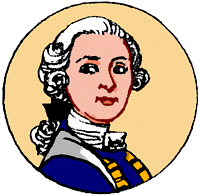 major mills of Reading, situated on
tributaries of the Kennet. One can only imagine the price he would have
had to pay for such lucrative urban mills. Further to this, he was one of
the founders of MAYs Brewery in Basingstoke. Thomas left a massive £96,000
at his death (£11,800 in cash), when he was described as a gentleman (May 1916). He had probably been so for some time as he had been
elected a Burgess of Basingstoke in 1783, though he was not sworn in due
to non-residence (Baigent &
Millard 1889, Ray 1904). Mary Anne May (1848-1932) recorded that he
“liked to dance at the Bath balls” wearing the fashionable coiffure
of those days (May 1916). She
knew his house and leasehold estate purely as Brimpton:
“a solid red brick house standing on a hill with a rookery behind it” (May
1916).
major mills of Reading, situated on
tributaries of the Kennet. One can only imagine the price he would have
had to pay for such lucrative urban mills. Further to this, he was one of
the founders of MAYs Brewery in Basingstoke. Thomas left a massive £96,000
at his death (£11,800 in cash), when he was described as a gentleman (May 1916). He had probably been so for some time as he had been
elected a Burgess of Basingstoke in 1783, though he was not sworn in due
to non-residence (Baigent &
Millard 1889, Ray 1904). Mary Anne May (1848-1932) recorded that he
“liked to dance at the Bath balls” wearing the fashionable coiffure
of those days (May 1916). She
knew his house and leasehold estate purely as Brimpton:
“a solid red brick house standing on a hill with a rookery behind it” (May
1916).
Thomas’ eldest son, also Thomas (1764-1843) is recorded as a gentleman or esquire, as is his brother, Charles (1767-1844). They lived in Brook Street in Basingstoke at Brewery House and Brook House respectively and owned and ran MAYs Brewery there. They were officially advertised as Brewers, Maltsters and Farmers, owning the large Glebe and Deep Lane Farms in Basingstoke also (McKenzie 1972, Hawker 1984). Thomas was one of the original proprietors of the Basingstoke Canal Navigation Company (1789), the local Justice of the Peace and Deputy Lieutenant of Hampshire (Baigent & Millard 1889). He became a Burgess of the town in 1794, Alderman in 1795 and Mayor in 1796, a post he held some eleven times! Charles was a Burgess in 1795, Alderman in 1810 and Mayor in 1811 and 1817 (Baigent & Millard 1889). He was also a lieutenant in the local volunteer Corps. (Ray 1904). His son, Charles (1800-1841) continued with the Brewery, but died three years before his aged father. He had been a Burgess of Basingstoke in 1824 and Mayor in 1839 (Baigent & Millard 1889), though the family appears to have spent much time down on the South Coast amongst fashionable society. Charles Junior died as an esquire. Daniel MAY (1771-1851) was the third son of Thomas MAY (1737-1800) of Brimpton. He was recorded as a gentleman and landed proprietor of six hundred acres of farmland, as well as owning Sonning Mill (7) and a meal business. He employed five men and three servants. According to the Book of Sonning, he also ran a fleet of barges on the Thames (Perkins 1977). Mary Anne MAY (1848-1932) records that he travelled quite a lot, going to France several times. His favourite spot was an old coaching inn in Hounslow where he would take his children, telling “the waiter to go and make buttered toast till they stopped him”. He is also known to have gone down to Southampton “to see Nelson’s ship, the Victory, towed in after the Battle of Trafalgar, when the decks were still stained with blood” (May 1916). His sons were: Thomas MAY (1808-1886) Esq. who travelled widely in Europe (8) but failed to become a diplomat, turning to his investments and settling in Bath (Somerset) where he was described as a gentleman; Walter MAY (1810-1900) Esq. who was a wealthy gentleman farmer (9) of Caversham, Grovelands Farm, Tilehurst and then Whitley Grove, Reading; Edmund (1816-1893) who was first Rector of St. George’s, Stamford (Lincolnshire) under the patronage of the Marquis of Exeter, then the fashionable St. Margaret’s Church in Bath (Somerset), before moving on to the parish church of All Cannings (Wiltshire), all highly respectable positions; and Morgan (1818-1902) who became an American pioneer and the leading figure of a large community: he had a township named after him. Thomas MAY (1737-1800) of Brimpton’s two youngest sons were John (b.1776) and William (1780-1862). They were millers in Reading at St. Giles Mill (and probably Minster Mill also), which they had inherited from their father. Both were gentlemen. John’s son, Henry (1804-1835) was a gentleman farmer of Mapledurham (Oxfordshire) and Edward (1805-1869), a surgeon in Reading and later Winchester.
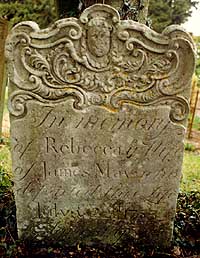 From about the
middle of the period of study onwards, gravestones and memorials begin to
become widespread. Those of the MAY family give a further idea of the
status of different branches. The earliest memorial is the gravestone of
Rebecca (BARBER) wife of James MAY (1700-1774) of Theale who died in 1755.
She was buried in her youngest son’s home parish of Brimpton. Alongside,
in the same churchyard, are the gravestones to her husband James (1774) (10),
her son Thomas (1800), daughter-in-law Mary (1819), grandaughter Jane
(1780) and grandaughter-in-law Elizabeth (1808). Rebecca’s stone is
beautifully carved with a cherub and scrollwork: a memorial worthy of a
respected yeoman family, though James’ is plainer. The remaining four
have the urn and palm-leaf motifs that were fashionable in the late
eighteenth century. James & Rebecca’s eldest son, James, has no
memorial but probably rests in the family vault beneath the elaborate tomb
chest monument in Englefield churchyard. This commemorates his daughter
Lucy (1754), daughter-in-law Isabella Catherina (1835) and mother-in-law
Sarah PRINCE (1779). Nearby is the plain and clearly cut gravestone to his
son Mr. John MAY (1809), and
grandson, James MAY (1840). His eldest son, James, was eminent enough to
have a small wall tablet commemorating him placed actually inside the
church (1805), alongside such eminent people as John PAULET, the 5th
Marquis of Winchester and his family. William MAY (1729-1797), the second
son of James of Theale, was buried in a family vault in Burghfield
churchyard, under a tomb chest monument not unlike that at Englefield.
Here are remembered William MAY (1797), Elizabeth his wife (1790),
Elizabeth his daughter (1794), John his infant son (1774), William his son
(1842), Elizabeth his daughter-in-law (1848) and Mary LYNE his
daughter-in-law’s sister (1855). Alongside are four low coped chest
memorials to William’s children: Catherine (1846), Charles (1847), Anne
(1846) and the latter’s husband, William COOPER (1850). Also nearby is
the gravestone of William’s aunt Jane (1775) and within the church is
another memorial tablet to William Junior and his wife. At Pangbourne are
the gravestones of Daniel MAY (1734-1773), James of Theale’s third son,
and his wife (1780) and eldest daughter (1844), though they are not of the
such high quality as those of his brothers.
From about the
middle of the period of study onwards, gravestones and memorials begin to
become widespread. Those of the MAY family give a further idea of the
status of different branches. The earliest memorial is the gravestone of
Rebecca (BARBER) wife of James MAY (1700-1774) of Theale who died in 1755.
She was buried in her youngest son’s home parish of Brimpton. Alongside,
in the same churchyard, are the gravestones to her husband James (1774) (10),
her son Thomas (1800), daughter-in-law Mary (1819), grandaughter Jane
(1780) and grandaughter-in-law Elizabeth (1808). Rebecca’s stone is
beautifully carved with a cherub and scrollwork: a memorial worthy of a
respected yeoman family, though James’ is plainer. The remaining four
have the urn and palm-leaf motifs that were fashionable in the late
eighteenth century. James & Rebecca’s eldest son, James, has no
memorial but probably rests in the family vault beneath the elaborate tomb
chest monument in Englefield churchyard. This commemorates his daughter
Lucy (1754), daughter-in-law Isabella Catherina (1835) and mother-in-law
Sarah PRINCE (1779). Nearby is the plain and clearly cut gravestone to his
son Mr. John MAY (1809), and
grandson, James MAY (1840). His eldest son, James, was eminent enough to
have a small wall tablet commemorating him placed actually inside the
church (1805), alongside such eminent people as John PAULET, the 5th
Marquis of Winchester and his family. William MAY (1729-1797), the second
son of James of Theale, was buried in a family vault in Burghfield
churchyard, under a tomb chest monument not unlike that at Englefield.
Here are remembered William MAY (1797), Elizabeth his wife (1790),
Elizabeth his daughter (1794), John his infant son (1774), William his son
(1842), Elizabeth his daughter-in-law (1848) and Mary LYNE his
daughter-in-law’s sister (1855). Alongside are four low coped chest
memorials to William’s children: Catherine (1846), Charles (1847), Anne
(1846) and the latter’s husband, William COOPER (1850). Also nearby is
the gravestone of William’s aunt Jane (1775) and within the church is
another memorial tablet to William Junior and his wife. At Pangbourne are
the gravestones of Daniel MAY (1734-1773), James of Theale’s third son,
and his wife (1780) and eldest daughter (1844), though they are not of the
such high quality as those of his brothers.
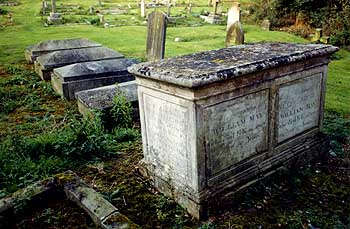 Thomas MAY
(1764-1843) of Basingstoke was another MAY elevated enough to have a
memorial tablet inside a church: that of St. Michael in Basingstoke.
Outside, three low coped chest monuments remember this man again (1843),
along with his brother Charles (1844), sister-in-law Sarah (1840), nephew
Charles (1841) and grand-niece Mary Anne (1847). They were once surrounded
by iron railings, no doubt carted away during the Second World War, and
there may be a vault beneath. Thomas and Charles’ brother, Daniel
(1771-1851), lies beneath a large, once railed, tomb chest in Sonning
churchyard, with his wife Eleanor (1858), grandson George (1845) and
daughters, Elizabeth Catherine (1839), Fanny (1847) and Caroline (1857).
These later memorials are post 1830, but give some idea of status achieved
during the period of study.
Thomas MAY
(1764-1843) of Basingstoke was another MAY elevated enough to have a
memorial tablet inside a church: that of St. Michael in Basingstoke.
Outside, three low coped chest monuments remember this man again (1843),
along with his brother Charles (1844), sister-in-law Sarah (1840), nephew
Charles (1841) and grand-niece Mary Anne (1847). They were once surrounded
by iron railings, no doubt carted away during the Second World War, and
there may be a vault beneath. Thomas and Charles’ brother, Daniel
(1771-1851), lies beneath a large, once railed, tomb chest in Sonning
churchyard, with his wife Eleanor (1858), grandson George (1845) and
daughters, Elizabeth Catherine (1839), Fanny (1847) and Caroline (1857).
These later memorials are post 1830, but give some idea of status achieved
during the period of study.
The elder
secondary branch of the family also had memorials. Though some of the
siblings of John MAY (1684-1752) of Sherfield had gravestones, he died
some twenty years before them when memorials were less common. His
sister-in-law, Rebecca (BARBER) MAY, died only three years after John
however, and she had a memorial, so why didn’t he? He was certainly
wealthy enough. In fact, John probably did have a memorial, one that has
not survived. Perhaps it was wooden. Perhaps it was seen as good building
material. His son, Thomas (1712-1769) of Worting was buried at Basing, as
was his wife, Catherine (1775), both with gravestones. The former’s
memorial is a fine highly carved example of the period, depicting an
hour-glass, symbol of the passing of time and thus the imminence of death.
Charles (1715-1745), the youngest son, was buried at Burghfield, but his
young widow, Mary, may not have been sure enough of her financial position
to erect a memorial. She, on the other hand, has a gravestone at Beenham
(1768), resting amongst her own family, the IREMONGERs. William
(1709-1777), the eldest son of John of Sherfield, has a fine gravestone at
Nately Scures, the oldest in the churchyard. Alongside are those of his
widow Ann (1799), son John (1802), daughter-in-law Ann (1827) and son
Charles (1807). All have urn and foliage carving, the three oldest being
identical and the others very similar. The large horizontal slabs of stone
which extend back from these may 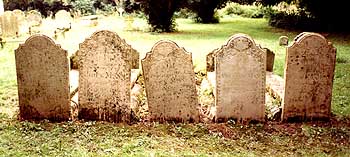 conceal an outside vault. William’s
other son, and namesake, William (1745-1828) has a double gravestone with
his wife, Lucy (1839), at Basing: a deep cut example executed by the best
of local stonemasons, Mr. LEE of Odiham. Next to them once stood the
stones to their daughter Lucy (MAY) GUNNELL (1837), son Daniel (1845) and
the latter’s wife Martha (1851). Only footstones now remain.
conceal an outside vault. William’s
other son, and namesake, William (1745-1828) has a double gravestone with
his wife, Lucy (1839), at Basing: a deep cut example executed by the best
of local stonemasons, Mr. LEE of Odiham. Next to them once stood the
stones to their daughter Lucy (MAY) GUNNELL (1837), son Daniel (1845) and
the latter’s wife Martha (1851). Only footstones now remain.
Charles MAY (1670-1714) of Basingstoke had the earliest known MAY memorial, but this no longer exists. He too was thought of enough to have a brass plate erected to his memory within a church: again this was St. Michael’s, Basingstoke. His son, Charles (1714), was also included and nearby were memorial tablets to his wife Ann (1745), son Christopher (1714) and daughter Elizabeth (1708). The memorials were removed when the church was restored in Victorian times (Baigent & Millard 1889, Attwood c.1988). Further MAY brasses were apparently removed from Basing Church in 1830 and sold by the vicar! (May 1916).
The courts, where the wills of the MAY family were proved, also tell of their status. Wills were usually proved in the local county or diocesanal court, but the Prerogative Court of Canterbury was used for those who died owning land in more than one county. However, by the seventeenth century, it had become a matter of prestige for all those of wealth and standing to have their wills proved at Canterbury, no matter where their land. Thus, the wills of Christopher MAY of Basing (1693), John MAY of Basing (1716), Charles MAY of Basingstoke (1714), Daniel MAY of Burghfield (1740), James MAY of Englefield (1772), William MAY of Burghfield (1797), Thomas MAY of Brimpton (1800), John MAY of Nately Scures (1802), Ann (WEBB MAY) WILLIS (1827), Charles MAY of Newnham (1807), Ann MAY of Caversham (1831), William MAY of Burghfield (1842), Mary MAY of Pangbourne (1845), Catherine MAY of Reading (1846) and Charles MAY of Ray Mead (1847) are to be found in the records of the Prerogative Court of Canterbury (the latter five were all written prior to 1830). It is interesting that the primary and elder secondary branches of the family particularly tended to keep to the local courts. Their money was mostly tied up in land from within a short distance of their home.
Several servants are mentioned in these wills, showing further the status of the MAY family. Especially notable is the coachman of William MAY Junior (1766-1842) of Burghfield.
As can be seen, the MAY family were wealthy and well thought of. Their social status appears to have been high throughout the period 1630 to 1830, though it fluctuated between yeoman and gentleman in different branches. Those MAYs not farming seem to have been of similar ranking to a yeoman, many later rising to become gentlemen also. The general trend appears to be for eldest sons to inherit the status of their fathers, some rising higher during their lifetimes. Younger sons seem to have started life at a social level below that of their elder brother, but only if he was a gentleman. If the eldest brother was of yeoman status, this was then universal across his siblings. Younger brothers could still rise in standing, even above that of their elders. Of course these conclusions are reliant purely on known information. Lack of details about certain family members may indicate they were less well off or moved away from the area. Nothing is known of John MAY (1630-1680) of Worting’s sons who lived in London, and little of Christopher (1656-1697) who was in Reading. Similarly, John’s brother, Thomas (b.1636), is something of an enigma, as is William (b.1679), youngest son of Christopher (d.1697) of Basing. The latter’s brothers, Christopher (d.1694) and John (1668-1716) seem to have made their way in life satisfactorily, but their children disappear from view. Thomas MAY (d.1718) of Nately Scures’ two sons Charles and Daniel outlived their parents and probably had families of which little is known: John MAY, an otherwise unknown cousin of Thomas MAY (1712-1769) of Worting (16), and the ancestors of one Thomas MAY (17) of Kent (May 1916). Certainly, Charles MAY (1670-1714) of Basingstoke did mention his poor relations in his will.
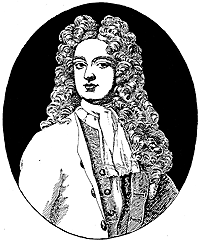 The primary branch
of the family rose from yeomen to gentlemen in the early eighteenth
century. The secondary branch rose similarly but did not become gentlemen
until the mid-eighteenth century. The elder group quickly reverted to
yeoman status in which it continued. John MAY (1795-1866) of
Sindlesham’s description of himself as a gentleman may have been wishful
thinking. The younger secondary branch retained gentleman status
throughout the eighteenth century and well past 1830. It seems probable
that it was because this branch of the family continued to hold property
in and have contact with the towns of Reading and Basingstoke, that they
did not take a step down the social ladder in the eighteenth century like
their cousins. Here there were more opportunities for investment and
profitable business ventures. Their associates, with whom they married and
did business, were clearly town people: the great SIMONDS family of
Reading, along with the HIGGS’ and RICHARDS’ of the same town, and the
SHEBBEAREs and ATTWOODs of Basingstoke. Names associated with the elder
branch are country orientated in the late eighteenth and early nineteenth
centuries: the GUNNELLs of Silchester, the LUNNs and MATTHEWs of Sherfield;
whereas previously they had done business with the WOODROFFEs and PITMANs,
Mayors of Basingstoke. The tertiary branch of the family rose to the
greatest social level in the earliest period, becoming Lords of the Manor
of Sulhamstead Abbots. This family had the most urban contacts and the
most diverse business, which enabled them to make money in the town before
investing in land in the countryside. Early contact with families like the
NOAKEs of Reading, NOYES’ of Andover and THOYTS’ of London, later
turned to include the landed TIPPINGs, Lords of the Manor of Woolley in
Chaddleworth. Further, Daniel MAY (1711-1753) of Sulhamstead was
apparently best of friends with the BLAGRAVEs of Southcote House, who
similarly had town and country interests. John BLAGRAVE was made trustee
for his heirs in 1753.
The primary branch
of the family rose from yeomen to gentlemen in the early eighteenth
century. The secondary branch rose similarly but did not become gentlemen
until the mid-eighteenth century. The elder group quickly reverted to
yeoman status in which it continued. John MAY (1795-1866) of
Sindlesham’s description of himself as a gentleman may have been wishful
thinking. The younger secondary branch retained gentleman status
throughout the eighteenth century and well past 1830. It seems probable
that it was because this branch of the family continued to hold property
in and have contact with the towns of Reading and Basingstoke, that they
did not take a step down the social ladder in the eighteenth century like
their cousins. Here there were more opportunities for investment and
profitable business ventures. Their associates, with whom they married and
did business, were clearly town people: the great SIMONDS family of
Reading, along with the HIGGS’ and RICHARDS’ of the same town, and the
SHEBBEAREs and ATTWOODs of Basingstoke. Names associated with the elder
branch are country orientated in the late eighteenth and early nineteenth
centuries: the GUNNELLs of Silchester, the LUNNs and MATTHEWs of Sherfield;
whereas previously they had done business with the WOODROFFEs and PITMANs,
Mayors of Basingstoke. The tertiary branch of the family rose to the
greatest social level in the earliest period, becoming Lords of the Manor
of Sulhamstead Abbots. This family had the most urban contacts and the
most diverse business, which enabled them to make money in the town before
investing in land in the countryside. Early contact with families like the
NOAKEs of Reading, NOYES’ of Andover and THOYTS’ of London, later
turned to include the landed TIPPINGs, Lords of the Manor of Woolley in
Chaddleworth. Further, Daniel MAY (1711-1753) of Sulhamstead was
apparently best of friends with the BLAGRAVEs of Southcote House, who
similarly had town and country interests. John BLAGRAVE was made trustee
for his heirs in 1753.